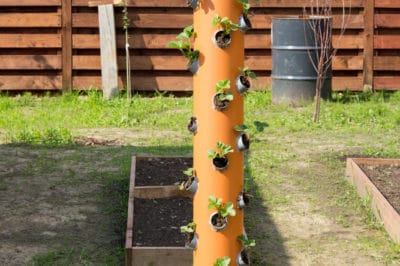Strawberry Tower – the Concept
A strawberry tower is simply a way to grow strawberries vertically. The tower contains all the soil the plants need and can be watered with drip irrigation. The tower can be set on a patio or deck or placed in the garden. A great space-saver, some towers can accommodate as many as 100 plants. That’s the equivalent of a 60-foot row of strawberries grown in the garden.
Growing Strawberries
No matter what tower you choose, remember these basics:
- Strawberries will grow well in USDA Zones 3 to 11; plant three weeks after the last frost.
- The plants prefer light, slightly acidic soil.
- Strawberries need regular water but don’t like soggy soil.
- Fertilize regularly for best crops and healthy plants.
- Always give strawberries full sun at least six hours a day. More is better.
The Shape of a Tower
The only consistent thing about a strawberry tower’s shape is that it’s basically a vertical planter. Many are shaped like tall, thin pyramids. One form is a straight, vertical, round tower with niches for each plant. A homemade form consists of a large piece of PVC drainage pie with holes drilled in the sides. You can even find towers set up to grow strawberries hydroponically or make a small one from a five-gallon bucket.
Wooden Stair-Step Tower
Plans for this kind of tower are easy to find on the internet. Think of this kind of tower as a pyramid; each step becomes a planting bed. The steps have no tops and each set of steps is slightly smaller than the one below it. The vertical board for each step can be removed, making it easy to replace soil once the nutrients become exhausted.
Commercial Towers
Commercial towers may be made of ceramic or plastic. Sometimes called stackable towers or vertical planters, they ofter have interlocking sections so you can make them smaller or larger as desired. Plastic towers have the advantage that they are lighter, but ceramic towers are very durable. However, ceramic towers are also more expensive.
Pipe Towers
The pipe tower offers the best option in terms of space saving, as it only takes up its diameter. A six-inch piece of PVC pipe is a standard size but you could go larger. It will be more stable if fastened to a plywood base. You drill holes in the pipe and fill it with soil. It is typically watered from the top, which is left open for access, or with drip irrigation.
How Many Plants to a Tower?
The number of plants to a tower will depend on the style and size of the tower. The pipe tower mentioned above has about 100 holes per five-foot tube. This system allows you to grow the most plants in the smallest amount of floor space. A typical stackable five-tier planter will hold 20 plants. A home-built wooden tower that is 18 inches on each side can accommodate about 90 plants.
Choosing Plants For a Strawberry Tower
June bearing, ever-bearing and day-neutral strawberries can all be grown in a strawberry tower. June bearers put out a lot of runners once they’re done producing fruit, which means extra effort to trim them. Ever-bearing and day-neutrals produce fewer runners. However, June bearers will give you the biggest crop and the biggest berries in a single large harvest.
Irrigation in a Strawberry Tower
The easiest way to water a strawberry tower – gravity being what it is – is from the top down. You can use a single sprayer or dripper positioned on the top of the tower. Some people run a small diameter soaker hose through the center of the tower, placing soil around it to hold it in place. You could also use a drip system with an emitter in each crevice or shelf of the planter.
Problems and Disadvantages
First, these towers are heavy – don’t expect to move them once they’re full of soil and plants. Towers with a broad base are fairly stable, but the PVC pipe should be anchored – ideally top and bottom. If you bump this kind of tower it could easily go over and smash. Sometimes watering tubes can get clogged. Wooden towers should be treated to resist moisture.
